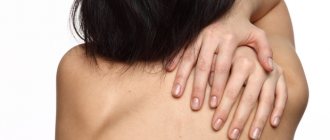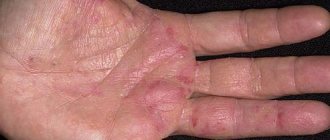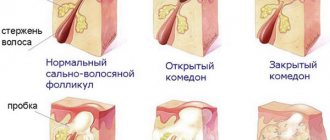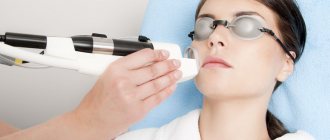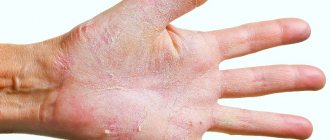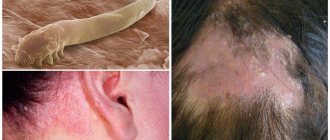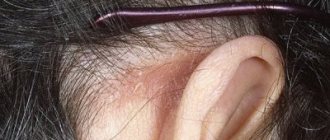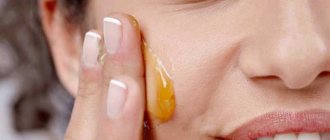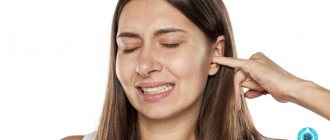Diagnostics
The diagnosis of exudative erythema multiforme in typical cases is not difficult.
However, in the febrile variant, before the appearance of characteristic rashes, one can think about many acute infectious diseases - influenza, typhoid, acute articular rheumatism, etc., and in the initial stage of confluent exudative erythema multiforme - about severe hemorrhagic measles, chicken pox, etc. Erythematous-papular exudative erythema must be differentiated from drug rashes (history, more severe itching, brownish tint, relapses after taking certain medications), urticaria (severe itching, irregularly shaped rashes, more rapid development and ephemerality, lack of a favorite localization), chills (red-violet color) . With tumoral lupus erythematosus, moderate punctate hyperkeratosis, a tendency to atrophy, a different course and a characteristic histological picture are detected. With erythema nodosum, the initial element is a node; their number is small, they are characterized by localization on the anterior surface of the legs and a change in color during the process of resolution. Sometimes exudative erythema multiforme may resemble indurated erythema of Bazin, annular Darier, or chronic migratory Afzelius-Lipschütz.
The erythematous-vesico-bullous form must be distinguished from Dühring's dermatitis herpetiformis (characteristic location of more profuse rashes causing burning or pain, absence of fever and general symptoms, eosinophilia in the contents of vesicles and blisters, predominant localization on the trunk, slower development, increased sensitivity to iodide potassium), ordinary chronic pemphigus (large blisters, develop slowly, usually on apparently healthy skin, Nikolsky's symptom is positive, the general condition is severe, acantholytic cells are in the smears), severe dermatosis (rapid course with a fatal outcome), erythematous pemphigus (Senir syndrome -Ascher, long-term course with exacerbations, positive Nikolsky sign, acantholytic cells), bullous toxicderma (history, relapses, itching or burning, accompanying purpuras, test results).
Erotic syphilitic papules on the mucous membranes are painless, darker in color, do not have a fringe of exfoliating epithelium, a bright inflammatory rim and are less prone to peripheral growth. They are accompanied by polyscleradenitis, positive serological reactions, and other manifestations of secondary syphilis. In the discharge you can find pale treponema. With foot and mouth disease there is diffuse stomatitis, often affecting the anogenital area, facial skin, limbs and around the nails, and gastrointestinal disorders. With various types of aphthosis, erosions are smaller in size, but deeper, rounded, and not prone to merging. They do not bleed and are not preceded by blistering.
Erythematous spots
Maculopapular and erythematous photo rash can also appear in the form of infiltrated papules, affecting in most cases various areas of the skin of the neck and face. Much less often, these manifestations can affect the skin of the body. As a rule, the medical prognosis is always positive and these neoplasms are benign.
The main cause of the development of maculopapular erythema is the toxic effects of streptococcal or staphylococcal infections in the human body. In addition, the reasons may lie in improper, unhealthy diet.
With proper treatment of papular neoplasms, there will be no visible signs of the disease on the skin. During treatment, itching and peeling of the epidermis on the affected areas of the skin may occur.
If you find such tumors on your body, you should immediately seek professional help from a specialist. The therapeutic course should be prescribed exclusively by the attending physician based on a detailed examination. Its effectiveness and recovery time depend on this.
It is extremely important to understand that the advanced form of erythema requires very long and difficult treatment in a hospital. It can leave a detrimental mark on the condition of the entire body as a whole.
Therefore, if you detect any manifestations of the symptoms listed in this article, you should call a doctor at home as soon as possible. Self-medication can only cause harm, aggravate the current condition, and also complicate diagnosis.
We looked at the erythematous rash photo with explanations. Have you ever seen a rash like this? Leave your opinion or feedback for everyone on the forum
What is erythema
Erythema is an infectious disease that provokes the appearance of a rash on the skin. Dilated capillaries are also a visible symptom of erythema. You need to understand that the nature of the rash depends on the individual characteristics of each person’s body, so the same disease can manifest itself differently in different people. This fact makes it much more difficult to determine the exact cause of the rash.
Erythematous skin rash in most cases affects children under twelve years of age, but the disease can also overtake an adult at the most inopportune moment. Modern medicine is not able to determine the causative agent of this infection, but it is known that the incubation period of erythema can last up to two weeks. The bacteria of this disease are transmitted by airborne droplets, so the patient should be isolated as quickly as possible.
Erythema in children and adults, photos with explanations
Erythema is redness of the epidermis. This reaction of the skin can be caused by an increase or decrease in air temperature, contact of the body with hot water and other similar factors. In this case, redness of the epidermis is not a cause for concern.
If the condition occurs for no apparent reason, it is recommended to seek medical help, since it may be a symptom of a disease that threatens not only the health, but also the life of a person.
Erythema: what is it?
Skin erythema is redness of the epidermis, which occurs due to dilation of capillaries. Such vessels are located directly in the skin. For this reason, a sharp flow of blood into them affects the change in skin tone.
The prerequisites for such manifestations are most often ordinary physiological processes, but it can also be associated with pathologies.
Erythema has such types as physiological and pathological disease. Each of them has its own reasons for its occurrence.
Physiological skin erythema quickly passes and is not a consequence of the development of pathologies. Here are the reasons for this type of redness:
- reaction to changes in the emotional background - shame, indignation and others;
- vegetative-vascular disorders that occur for natural reasons, for example, during menopause or during pregnancy;
- physical impact - blow, rubbing and others;
- change in air temperature - heat or frost;
- use of medications that cause vasodilation;
- contact with the epidermis of any substances that irritate the skin - household chemicals, various ointments and other products.
This type of redness, pathological erythema, occurs due to any disease. Here are the causes of this disease:
- general pathologies caused by infections;
- chronic skin diseases - chronic erythema;
- diseases of the epidermis of non-infectious and infectious nature;
- autoimmune pathologies;
- allergies, especially to medications;
- somatic pathologies;
- physiotherapy;
- a reaction of the epidermis to ultraviolet radiation, which is called solar erythema.
The occurrence of redness often occurs due to several reasons. To cure a disease, it is necessary to get rid of the factor that caused it.
Erythema nodosum
The symptomatology of this form of pathology is the presence of red spots on the surface of the skin. They have a dense structure, and their presence on the epidermis causes discomfort in the patient. You can learn more about erythema nodosum here.
The characteristic manifestations of the disease are that the spots appear suddenly and also disappear unexpectedly. They can go away quickly or within a few days after their appearance.
In the nodular form, the inflammatory process occurs in the thickness of the epidermis and in the fatty tissue. The diameter of the rash ranges from one to ten centimeters. Locations: inner thigh and lower leg. Facial erythema in this case is extremely rare.
The manifestation of pathology is influenced by viruses that penetrate the body. In this case, the following manifestations are added to the underlying symptoms: pain in the joints, increased body temperature, inflammation of the mucous membrane of the organs of vision and general malaise.
Viral erythema
Erythema in a child develops due to the penetration of viruses into the body. Children aged 2 to 4 years are susceptible to pathology. Most often, the disease due to viruses appears in the spring or autumn. Characteristic symptoms of the pathology:
- sore throat;
- temperature increase;
- itching in the nose;
- pain in the head area;
- rhinitis;
- the appearance of rashes on the epidermis and in the oral cavity several days after viruses enter the body.
Ring-shaped erythema
Among childhood diseases, there is a disease characterized by the growth of ring-shaped spots, which choose their location on the child’s torso or limbs. The second name for annular erythema in children is annular centrifugal erythema of Darier. Usually a short-term illness, but as a result of the child’s elevated emotional threshold, it can last a long time. Boys suffer less from this disease than girls.
Clinical picture
The pathological picture is characterized by the appearance of pinkish-red or yellowish-tinged non-flaky patchy formations. They are slightly swollen, growing in disarray, gradually forming elements of rings tied into a garland. The dimensions of each garland can reach up to 20 cm or more. The difficulty is that the birth of new spots growing along the periphery, along with old ones that appeared earlier, forms extensive arched, bizarrely shaped garlands of focal lesions.
Gradually, the formations begin to change their shades to brown and brownish-olive. The location of the spots is the body, parts of the limbs. Symptoms such as itching are not always present. There are atypical forms. It manifests itself as peeling and the appearance of small bubbles on the surface. Ring-shaped erythema in children occurs in a chronic form and can last up to several years. In this case, relapses of the disease are observed.
Treatment
Whatever erythema in children, long-term treatment is required, but can also be carried out at home. The etiology of each form will dictate the choice of drugs. The main method is treatment with antibiotics through injections.
Causes
Frequent reasons for the development of erythema in children are:
- hereditary predisposition in the family;
- sinusitis, chronic tonsillitis;
- weakened immune system.
General symptoms of erythema
Signs are indicated:
- headaches;
- general malaise;
- presence of temperature;
- the appearance of lesions in the form of edema, rings protruding above the surface of the skin, united into rings.
Classification of pathology
Depending on the cause of its occurrence, erythema has a certain character:
- infectious (pathological) – provoked by nonspecific pathogens that have entered the surface of the epidermis, mucous membranes, and into the systemic bloodstream;
- non-infectious - caused by physiological reactions of the body in response to internal or external stimuli.
The infectious type of reaction occurs in acute and chronic forms. Usually the inflammatory process begins with a pronounced clinical picture. If left untreated, the symptoms fade away, and the pathology becomes chronic with periodic exacerbations.
Depending on what symptoms the erythema has and the appropriate treatment is chosen. The clinical picture of the reaction depends on its causative agent. With a skin rash, the patient experiences itching, discomfort, and pain. Some forms of the inflammatory process occur with an increase in body temperature to critical levels, dyspeptic disorders, weakness and a general deterioration in well-being. Inclusions may have a smoothed surface, papules and macules, and watery pimples.
Non-infectious
The human body has protective reactions. In response to the stimulus, the immune system is activated with characteristic manifestations. Non-infectious forms of skin reactions are classified according to the causes of their occurrence.
- Infrared - develops due to prolonged contact with infrared rays, the strength of which does not allow the epidermis to receive a full-fledged burn. It is characterized by the appearance of reddish spots in the form of a mesh on the surface of the epidermis.
- X-ray – formed when exposed to X-rays or electromagnetic waves. Accompanied by the formation of inclusions with clear boundaries.
- Symptomatic (fixing) – occurs upon contact with an allergen, often after eating certain foods and medications. A characteristic sign of fixed erythema is hyperemia of the skin in the form of a spot with uneven edges and bulges.
- Idiopathic (hereditary) - is formed when the lumen of the capillaries in the places adjacent to the common vascular network increases. It is accompanied by redness on the surface of the palms and in some cases spreads to the feet.
- Cold - occurs during prolonged contact of the skin with low temperatures. A reddish-bluish rash on the skin is accompanied by local swelling and itching.
- Ultraviolet - caused by the skin's reaction to exposure to ultraviolet rays. It has a complex of symptoms of varying intensity - from local hyperemia to the formation of blisters with damage to deep layers.
Physiological skin reactions have pronounced, rapidly increasing symptoms, and treatment must be started immediately. The main point in the treatment of the inflammatory process is to limit contact with the irritant. A physiological rash can occur as a result of prolonged friction of the epidermis (for example, during massage) or due to psycho-emotional arousal. There are cases when skin hyperemia appeared during orgasm and hypnosis.
Treatment of non-infectious rash involves providing symptomatic care. The patient is prescribed antipruritic antihistamines, antispasmodics, painkillers and medications that accelerate tissue regeneration.
There is a hypothesis that physiological erythema has psychosomatic causes.
Infectious (pathological)
Erythema is pathological in nature when caused by infectious agents: viruses, fungi, bacteria, parasites. This form is acute, but can become chronic. It is more difficult to cure the latter, therefore, if the disease is pathological, a person requires immediate medical attention.
Erythema infectiosum is classified according to the causes and symptoms of the disease. Each form has individual treatment.
Erythema nodosum and its symptoms
The onset of the disease expresses in children an increase in sensitivity to certain diseases. Diagnosis of the disease indicates the onset of a primary infection. Symptoms of skin lesions of erythema nodosum in children can be observed individually. Many of them depend on the cause of the onset of the disease.
The most striking signs are:
- formation of red nodules;
- spots that predominate on the front of the lower legs;
- the incubation period before rash can be several weeks;
- accompanying muscle and joint pain;
- general malaise;
- low-grade or high fever;
- merging of nodular formations into a large ring, up to 10-13 cm in diameter;
Causes of erythema nodosum
Erythema nodosum occurs more often in children over 5 years of age. By adolescence, the degree of infection is high. Various factors can trigger an infection:
- tuberculosis;
- use of sulfonamides;
- streptococcal infection, brucellosis, histoplasmosis;
- very rarely sarcoidosis;
- BCG vaccination;
Clinical picture of erythema nodosum in children
Erythema nodosum in children can be localized alternately on one leg, then on the other. All nodular rashes are localized above the ankles, without crossing the border. The exception is the appearance of spots on the shoulders or in the bridge of the nose, in the upper part of the cheeks, and on the earlobes.
Gradually, the nodes become denser and become painful. After two or three days they increase in size, acquiring intense color. Over time, pain and tension decrease, and folds remain in place of the nodular formations.
After a week, the erythematous nodes become bluish-brown. They are replaced by brownish pigment spots. These first rashes last up to several weeks. Subsequently, a new rash may appear.
The main changes affect the lobules of adipose tissue in the subcutaneous tissue and in the connective tissue of the septa. In the acute form, swelling, redness, and an increase in white blood cells are observed. As the acute form weakens, huge foreign body cells take their place and collagen fibers in the skin degenerate. Pathological changes begin to affect the walls of the venous vessels.
Diagnosis of erythema nodosum
Rashes of erythematous nodes are difficult to confuse with similar phenomena of other infections. Sometimes such rashes resemble the picture after insect bites. But you must definitely remember about the localization of rashes on the child’s body. Erythema in children has limitations, which makes it possible to differentiate it from other infections. Tuberculin tests are taken, the dynamics of which should be paid attention to.
Kinds
Pathology amazes with the variety of types - there are 28 of them:
- Persistent towering. Another name is persistent erythema. A rare disease with an unspecified etiology. Oblong ridges of rich red color are formed.
- Dychromic. One of the varieties of red lichen. The spots are ash-blue. No treatment has been developed.
- Stevens-Johnson. A variety of multiform. Characterized by general intoxication.
- Viral. It begins as an acute viral disease, but is distinguished by a small rash resembling diathesis. It appears in the initial stage on the cheeks, then on the internal organs. Children of primary preschool age are most often affected. The danger lies in damage to the functions of hematopoiesis, joints and bone marrow.
- Infectious. It is caused by parvovirus, and the main risk group is preschool children. The rash covers the cheeks, then the entire body. It is often asymptomatic.
- Symptomatic. They cause emotions - anger, shame, excitement.
- Chamera. The etiology of the disease is infectious. The rash has the appearance of a butterfly, the rash merges into large spots. It is not difficult to tolerate and is accompanied by symptoms of mild intoxication.
- Polymorphic. One of the types of erythema multiforme. The rash occurs in the form of spots, hemorrhagic effusions, nodules and blisters filled with liquid.
- Physiological. Appears when there is a difference in temperature or under the influence of natural irritants. It is observed in infants in the postpartum period. It goes away on its own.
- Centrifugal erythema of Biette. Refers to a type of lupus erythematosus.
- Centrifugal erythema of Daria. Rash in the form of rings with unknown etiology.
- Ring-shaped. Occurs with weak immunity, cancer, fungal and bacterial infections. The body is covered with huge spots in the form of rings.
- Toxic form of newborns. It is of allergic origin. Treated with antihistamines.
- Exudative multiform - has a toxic-allergic nature. Sore throat, headache, muscles. The rash grows up to 3 centimeters, the spots merge into large “continents” and have a bluish tint. They appear symmetrically on the body and frame the lips on the face. Pain and itching are felt.
- Radial. Appears as a reaction to an x-ray examination.
- Scarlatiniform. The causative agents are streptococci and staphylococci. The prognosis is favorable.
- Nodular - the course of the disease can be acute or chronic. The rash looks like nodules that are painful to the touch. The diameter of the papules varies from ½ to 5 centimeters. There are practically no rashes on the face.
- Solar. Appears during prolonged exposure to the open sun, sometimes it is of an allergic nature. Hyperthermia is accompanied by swelling and deterioration of well-being.
- Miliana. Appears as a result of an allergy to the anti-syphilis drug salvarsan.
- Cold. Occurs as a reaction to cold. There is no specific therapy.
- Twisty Gammel. Resembles a cut of a tree, found in cancer.
- Bordered. Autoimmune response to the administration of medicinal serums. Manifested by urticaria.
- Afzelius-Lipschütz. Borreliosis or Lyme disease. The causative agent of the disease is a tick. Antibacterial and symptomatic therapy is carried out.
- Telangiectatic Bloom. The second name is infrared. Occurs with prolonged exposure to infrared radiation - a fireplace, heating pad.
- Palmarnaya. Popularly called “liver palms”. Hyperemia is noted over the entire area of the palms. Cause abnormal liver and blood diseases, rheumatoid arthritis.
- Vascular erythema.
- Nodose. Synonym for knotty. Creeping.
Depending on the factors of occurrence, infectious and non-infectious hyperthermia are distinguished.
Infectious diseases include:
- exanthema;
- Lyme disease;
- multiform;
- undifferentiated;
- migratory;
- nodal
Non-infectious forms cause autoimmune reactions of the body to external stimuli.
Non-infectious forms:
- x-ray (radiation);
- persistent;
- infrared.
Symptoms of various clinical forms
How the disease manifests depends on the form of the disease, age, and concomitant pathologies:
- Chamer's erythema is considered a mild manifestation of the disease. The temperature does not rise above low-grade fever, there is a slight sore throat and redness of the conjunctiva. The main symptom is a rash that appears on the face, then on the body. At the beginning of the disease, it appears as small bright red spots, which subsequently merge and resemble the silhouette of a butterfly. With this form of the disease, the rash lasts about two weeks, after which it gradually turns pale and disappears, leaving no traces. Sometimes excessive physical or mental stress, as well as abuse of ultraviolet radiation, can trigger a recurrence of the rash.
- Symptoms of Rosenberg's erythema are characterized by a pronounced onset, prolonged debilitating fever, and manifestations of intoxication of the body: weakness, headaches, sleep disturbance. A feature of this form is muscle and joint pain. The rash, which appears after 4–5 days, is also found in large joints, on the elbows and popliteal folds, and in the buttock area. There are no rashes on the face completely. Extensive erythematous redness lasts about 5–6 days, may be accompanied by swelling, after which the disease subsides.
- Exudative viral erythema is severe with severe intoxication and prolonged fever. The rash looks like itchy blisters with clear exudate inside, covers the entire body, and can spread to the mucous membranes. When the blisters open, they become covered with a crust, after which disappears small ulcers may remain. The exudative form in severe cases can cause erosive lesions of the mucous membranes of the mouth, pharynx, and genitals.
- Sudden erythema is characterized by an extremely abrupt onset and rapid progression. The temperature rises to 40 degrees and stays within this range for 2-3 days. After which a pale pink rash appears, covering the entire body, limbs, face, and the temperature returns to normal. The disappearance of the rash begins after 3–4 days.
- Erythema nodosum is characterized by the appearance of a dense, painful rash that forms mainly on the extremities. The nodules are large (up to 5 cm), protruding above the surface of the body. Their color gradually changes as the disease subsides from bright red to greenish. With this form, moderate temperature, pain and slight swelling of the joints are noted. The duration of the disease is 1–3 weeks.
Since erythema often begins as a respiratory disease, and the rash appears several days later when the body temperature returns to normal, this disease often goes undiagnosed in infants.
It is often confused with an allergic reaction to food or dermatitis.
Sudden erythema begins with a sharp rise in temperature and the appearance of a pink rash
Signs
It manifests itself in different ways and depends on the type of disease.
Caused by infection, it is accompanied by fever, aches and swelling of the joints. The onset is acute, with severe headache, weakness, and chills.
Exudative erythema is the most dangerous and can lead to death. It begins with general symptoms of illness - aches and pain in muscles and joints, headache and sore throat. The rash covers the skin of the forearms, palms, palms and soles, mucous membranes of the oral cavity and nasopharynx. In addition to spots, the skin is covered with papules with serous contents. They burst and form open bleeding ulcers.
Lyme disease is viral in origin. The carriers are ticks. Persistent redness appears at the site of the bite, which increases in size. Accompanied by tissue compaction at the site of suction, and symptoms of damage to the central nervous system and musculoskeletal system.
One type of erythema is exanthema. It begins acutely, with an increase in body temperature, accompanied by headache and emotional agitation. After a few days, the headache subsides, and a pink, erythematous rash covers the body. After recovery, the skin returns to its original appearance.
Treatment of erythema infectiosum in a child
Erythema infectiosum refers to a childhood disease of the skin and mucous membranes. It manifests itself as partial or complete redness of the child’s skin and is accompanied by fever. In everyday life it is called pseudorubella, spanked cheek disease or the 5th childhood disease. The disease rarely occurs in adults; it is mainly diagnosed between the ages of 4 and 12 years.
Causes of erythema and its symptoms
The exact causative agent of the disease has not been identified to date. The disease is classified as viral and can arise against the background of allergies, pseudotuberculosis, rheumatism, and lupus erythematosus. Physiological reasons also have an impact:
- expansion of capillaries;
- outdoor games;
- massage;
- burns;
- skin squeezing or blow;
- diseases of internal organs.
Symptoms are different and depend on the age of the child, existing pathologies at the time of the inflammatory process, and problems with blood circulation. Based on external indicators, erythema is often confused with rubella, measles or scarlet fever.
The main distinguishing feature of erythema infectiosum is its similarity to a viral disease (cold, flu); fever, flushing of the skin of the cheeks and a rash on the body are manifested. After direct exposure to the virus on the child’s body, the following symptoms appear two days later:
- sudden temperature rises up to 39°C, chills;
- pain in the head and abdomen;
- joint pain;
- general malaise;
- decreased appetite;
- runny nose and sore throat;
- red rash.
How does the rash occur?
The rash usually covers the skin on the 5th day of illness; it is quite abundant, mostly spotty, and on the extremities the shape is more like lace. The elements of the rash gradually turn pale and then disappear. Does not leave external defects on the skin in the form of scars and altered pigmentation. It is of a specific nature and has several stages.
At first, the cheeks become bright red and looking at the child you might think that he was whipped on the cheeks. Sometimes the rash affects the area of the chin and forehead, but it lasts only a couple of days and then disappears.
In the next stage, the rash covers the torso, shoulders, neck, knees and buttocks. All this appears in the form of red spots. The rash on the body can last up to a week, and is accompanied by severe itching.
After it disappears, peeling forms. In the near future after the lesions disappear, skin contact with chemicals, direct exposure of the child to the sun, any physical activity, excitement and stress should be avoided. This may cause the rash to reappear in the same places. The mucous membrane of the mouth may also be affected.
The incubation period lasts 5-14 days, in rare cases it can last up to 28 days.
Erythema infectiosum can develop in various forms:
- the typical form is characterized by focal damage with a rash, lethargy, and fever;
- atypical development of the disease is accompanied by swelling of the joints of the arms and legs;
- the hepatitis form is determined by an enlarged liver, noticeable yellowness of the eyes and skin, pain in the right hypochondrium;
- There is also an asymptomatic development of the disease until it somehow manifests itself.
Main types of erythema infectiosum
- Knotty. Usually indicates the presence of streptococcus. Characteristic are nodular formations on the skin, mainly on the legs.
- Multiform. The rash occurs in large quantities and can take on various forms. Fever, headache and weakness.
- Migratory. The symptoms are similar to Lyme disease. Occurs after an insect bite, such as a tick. After swelling, a red spot appears at the site of the bite and over time expands to 15 cm in diameter.
- Sudden exanthema.
Most common in children aged 6-24 months. After the first fever, a rash appears immediately and lasts no more than 6 days. Triggered by the herpes virus. - Infectious erythema of Chamer and Rosenberg.
Expressed in a feverish state, intoxication, multiple spots on the body.
How to correctly diagnose the disease
Due to the difficulty of clinical diagnosis, its presence is initially suspected by the presence of a “lace”-shaped rash.
To be convinced of erythema infectiosum, you will need a number of laboratory tests: a blood test to determine the number of leukocytes and platelets, an examination to determine the presence of the necessary antibodies to a viral disease, and detection of viral DNA. The subsequent result will enable the specialist to prescribe effective therapy.
Is erythema infectiosum contagious?
The disease itself is caused by paravirus B19. It is believed that the route of infection is airborne, but unlike other viral diseases, there is no presence of the pathogen in the nasopharynx. Erythema virus is not excreted in urine or feces. When the rash stage occurs, the patient becomes non-infectious and no quarantine measures are necessary.
What are the dangers of complications of the disease?
The likelihood of various complications after erythema infectiosum is not high, but it does exist. During the course of the disease, red blood cell synthesis may stop.
If the child does not have problems with hematopoiesis, then the complication will not cause significant problems. But if there are disturbances in the blood system, the patient is at high risk of even greater complications with blood function.
Aplastic crisis may occur up to 10 days.
If the patient already suffers from aplastic anemia, then he experiences an exacerbation. In such cases, erythema infectiosum will be accompanied by frequent attacks of fever, rapid heartbeat, and apathy.
A child suffering from immunodeficiency may well develop a chronic form of the disease, which in the future will lead to the development of pathological damage to hematopoiesis and a persistent form of anemia. The condition is completely reversible, but theoretically can lead to death.
Treatment of erythema infectiosum
The recovery process primarily involves home treatment. The principle of action is similar to methods of treating viral diseases:
- bed rest
- increasing fluid intake
- strict restrictions on bathing and sun exposure
- antiviral drugs
It is recommended to use dressings with ointments and follow a diet that prohibits consuming everything fatty, salty, smoked and fried, and avoiding canned food, chocolate and citrus fruits.
Long walking, heavy lifting and hypothermia should be avoided. To eliminate symptoms, antihistamines, antipyretics, antiallergics, analgesics for severe pain, peripheral hemokinators, and iodide alkalis may be prescribed. Antibiotics can be prescribed only if erythema is accompanied by tonsillitis, pneumonia, otitis media or other microbial complications.
Treatment of erythema infectiosum can be carried out in an outpatient hospital setting, especially with weakened immunity, blood diseases and during pregnancy. Infection during pregnancy is very dangerous due to the possibility of infecting the fetus, which sometimes leads to spontaneous abortion.
Severe disease is the basis for initiating corticosteroid therapy. It does not have a narrowly targeted effect on the paravirus, but can have a strong effect on the functioning of the immune system.
After the end of the disease, a person acquires lifelong immunity to erythema infectiosum and will never get sick with it again.
Preventive actions
It is easy to become infected with this viral infection from a carrier, since the disease can be asymptomatic. It is impossible to recognize these people, and therefore there is no specific prevention against erythema infectiosum. But there is an opportunity to reduce the risk of getting it.
- Avoid close contact with people who have cold symptoms such as runny nose and cough
- avoid crowds of people
- do not use other people's handkerchiefs, cutlery and other personal items
- wash your hands after going outside
- Strengthen your immune system with healthy eating and walking
- toughen up and play sports
Serious measures to prevent infection have not been developed. Self-medication is inappropriate, since most symptoms are very similar to infectious and dermatological diseases. If you experience persistent symptoms similar to erythema infectiosum, you should consult a physician or dermatologist.
Source: https://furunkul.com/drugie-zabolevaniya-kozhi/infektsionnaya-eritema-u-detey.html
Erythema multiforme exudative
The disease begins suddenly with fever, general malaise and headache. A rash in the form of red spots appears on the limbs, face, genitals and often on the mucous membrane of the mouth, the spots are symmetrically located and slightly raised above the surface of the skin.
The central part becomes bluish-red, while the rest remains bright red and rises to the center. The rash may appear in bumps up to 1 cm in size. Crusted blisters may appear, then ulcers form in their place. The duration of the disease is 10–15 days and then, as a rule, everything resolves safely. Relapses are possible with repeated use of medications that cause the disease.
But there is a severe manifestation of the pathology - this is Stevens-Johnson syndrome, which occurs as an acute infectious disease: large temperature changes for 2-3 weeks, affecting the skin, internal organs, mucous membrane of the mouth and eyes.
In addition to the usual rashes, large blisters appear on the skin; in the mouth - painful and bleeding ulcers. Erythema can be complicated by inflammation of the cornea, pneumonia, meningitis, etc. There is a possibility of death.
Causes
It is not completely clear, but there are 2 options for the origin of erythema multiforme exudative:
- infectious-allergic (or viral) origin. At the same time, most patients are diagnosed with a chronic infection and periods of exacerbation of the disease occur mainly in early spring and late autumn - during the cold and damp period of the year.
- oxy-allergic origin, mainly to drugs. This form of the disease is essentially no different from drug toxicoderma.
Treatment
Initially, patients are examined to identify possible chronic infections. Depending on the origin of the erythema, the following are prescribed: broad-spectrum antibiotics (but for toxic-allergic causes of the disease, antibiotics are not prescribed), antihistamines, anti-inflammatory drugs. In severe cases, hormonal drugs (prednisolone).
For Stevens-Johnson syndrome, large doses of prednisolone are prescribed, as well as agents for removing toxins (hemodez, polyglucin). Anti-inflammatory, antibacterial, hormonal ointments (Gyoksizon) are used externally.
In case of rashes in the form of bubbles, they are opened and lubricated with a solution of pyoctanin or Fukortsin. If the oral mucosa is damaged, disinfectant and astringent rinses are prescribed; food should be liquid and not irritate the mucous membrane. In cases of eye damage, eye drops are used. Patients with erythema multiforme should avoid hypothermia and maintain bed rest
Treatment
Before starting therapy, the attending physician must determine whether erythema is an independent disease or a manifestation of another, systemic pathology. In the second case, the fight against skin symptoms will be part of general medical measures. Considering the possible consequences of erroneous diagnosis and self-medication, any therapeutic measures should be applied solely based on the results of an examination by a specialist.
Drug therapy
The use of medications is directed primarily against the causative agent of the erythematous condition . For viral infections, specific interferons (alpha and gamma classes) and immunostimulants (Kagocel, Cycloferon, Tsitovir-3) are used. Bacterial agents are suppressed by broad-spectrum antibiotics (Lincomycin, Tetracycline, Ceftriaxone, Erythromycin).
Treatment of affected skin is carried out using antimicrobial and regenerating agents:
- Amidopyrine;
- Iruxola;
- Calamina;
- Vishnevsky ointment;
- Solcoseryl;
- Ethacridine lactate.
Inflammatory processes are relieved with antihistamines (Zyrtec, Claritin, Loratadine, Suprastin, Cetirizine, Erius) and corticosteroids (Prednisolone, Dexamethasone). Tissue restoration is accelerated by complex preparations containing vitamins A, B12, D, E.
Severe hematopoietic disorders accompanying Stevens-Johnson syndrome may require red blood cell transfusion.
Diet
First of all, when erythema occurs, it is necessary to exclude from the patient’s diet all foods that can cause an allergic reaction in him. This recommendation is also effective if we are talking about an infectious form of the disease - even without being the cause of the inflammatory process, extraneous irritants can complicate its course.
Also undesirable for use:
- fatty food;
- smoked meats;
- coffee;
- strong tea;
- foods high in preservatives;
- chocolate.
Photo gallery: products contraindicated for erythema
Chocolate causes an allergic reaction in some people
Synthetic ingredients in food are often allergens
Smoked products can be irritating
Strong stimulant drinks may increase inflammation
Fatty foods put extra strain on your metabolism
On the contrary, it is recommended to increase the content in the diet:
- legumes (green beans, peas);
- green spices (cumin, dill);
- porridge (buckwheat, oatmeal);
- fermented milk products;
- root vegetables (carrots, beets, turnips).
Physiotherapy
Local physiotherapeutic effects help reduce skin inflammation, ease irritation and itching, and speed up regeneration processes. These include:
- laser therapy;
- magnetic therapy;
- ultraviolet irradiation;
- phonophoresis with corticosteroids.
During the treatment period, prolonged exposure to direct sunlight, as well as exposure to high temperatures, including hot baths, is contraindicated..
Folk remedies
Infusions and herbal preparations containing:
- immortelle;
- nettle;
- birch leaves;
- lemon balm;
- peppermint;
- hawthorn fruits;
- yarrow;
- elderberries.
To obtain them you need 4 tbsp. l. dry ingredients - individual herbs or a mixture of them, composed in equal proportions - pour two glasses of boiling water, leave in a thermos for half an hour to two hours. The finished mixture needs to be strained, and then consumed ½ glass three times a day before meals.
For severe skin irritation, cooling baths with oatmeal or starch help.
General clinical picture
Most often, a squamous rash of the same type accompanies completely different disorders that occur inside the human body. The term erythema includes some physiological and most pathological conditions of the skin and mucous membranes. They are caused by the expansion of skin capillaries and can appear single or multiple, often merging with each other as pink or red spots of various sizes. Depending on the main cause of the development of the disease, spots are distinguished between physiological and those arising due to pathological conditions.
For example, physiological erythema is distinguished by its short duration, without being considered a consequence of general or local disorders in the human body. Physiological erotema can occur:
- As a result of temperature or physical effects.
- As a reflex reaction during the expression of psycho-emotional instability, for example, joy, excitement, shame, as well as in functional vegetative-vascular disorders, including menopause.
- If any irritating substances come into contact with the skin, for example, alcohol solutions, warming ointments and creams, as well as when taking medications with a vasodilator effect: antihypertensive drugs, nicotinic acid and others.
Pathological erythema is caused by a number of other reasons. The main causes of this type of disease will be as follows:
- Non-infectious and infectious diseases of the skin: dermatoses and dermatitis.
- Infectious diseases of a general nature.
- Autoimmune connective tissue diseases and allergic reactions, in particular to certain medications: non-steroidal anti-inflammatory drugs, penicillin antibiotics and sulfonamides, anticonvulsants, antidepressants, combined oral contraceptives.
- Somatic pathology, for example, circulatory disorders, pulmonary sarcoidosis, Crohn's disease, and pregnancy.
- Physiotherapeutic thermal procedures, solar irradiation, other electrical procedures.
Erythema of the skin and mucous membranes is most often diagnosed in genetically predisposed young patients, whose age ranges from 20 to 30 years, regardless of gender. The disease mainly occurs in those people who are exposed to excessive sun exposure. The disease can be multifactorial in nature, that is, it can be provoked not by one of the factors, but by several at once.
What it is
Erythema is a pronounced vascular reaction on the skin caused by a strong rush of blood to its surface.
This phenomenon can be physiological (natural), for example, appear on the face during severe emotional stress in adults or during prolonged crying in a child.
Erythema can also be a consequence of sunburn, trauma and scratching of the skin, or insect bites. Usually in such cases it does not require treatment. As soon as the provoking factor is eliminated, the redness on the body disappears.
Pathological erythema is caused by toxic effects on the body, endocrine disorders, bacterial, viral or fungal infections. Their symptoms and treatment vary depending on the type of disease.
The manifestations of erythema are very diverse, they vary from slight redness to the formation of large lesions, with thickening of the epidermis, nodular changes in peripheral vessels, profuse rash in the form of papules, pustules, plaques, roseola, blisters, etc.
Causes of the disease
Redness often occurs as a result of intense friction of the skin and exposure to sunlight. Another reason is chemical burns. Erythema may also appear after physical therapy using electric current. Often the cause of the disease is allergies, various types of dermatitis, impaired blood supply to the skin, and infectious diseases.
Depending on the form in which erythema manifests itself, the reasons for the development of this condition may be as follows.
- Erythema migrans in most cases manifests itself after tick bites.
- Ring-shaped is provoked by poisoning and intoxication of the body. Sometimes the cause of this disease is an allergy, an infectious disease, or a malignant tumor.
- Erythema nodosum can be caused by allergic reactions of the body, general intoxication, to which sometimes a virus is added. In this case, the patient’s well-being deteriorates significantly.
- The cause of solar erythema is too intense or prolonged exposure to ultraviolet rays on the skin.
- Viral erythema is the result of penetration of bacteria, viruses, and pathogenic microflora into the epithelium or deeper layers.
- Exudative eczema is provoked by staphylococci and streptococci. The cause of its appearance may be the herpes virus.
- After taking certain categories of medications, a fixed form of the disease may appear.
- Palmar erythema usually develops against the background of liver failure, rheumatoid arthritis, and diseases of the circulatory system. Sometimes it is caused by pregnancy. It may be congenital - in this case it does not require treatment.
- The reasons for the appearance of persistent erythema are not precisely known; presumably, this is one of the manifestations of allergies or a subtype of granuloma.
Prognosis and prevention
As clinical practice shows, the prognosis in terms of recovery for the main forms of the disease is favorable. However, in severe cases and the development of Stevens-Johnson syndrome against the background of exudative erythema, the prognosis is unfavorable. Even death is possible.
To date, preventive measures against the occurrence of erythema infectiosum are not applied. Carrying out special measures at the source of infection is not provided. A vaccine is being developed to provide specific prophylaxis that can prevent infection with parvovirus B19. Some leading experts are working on a universal vaccine that can protect a person from several infectious diseases at once, such as measles, mumps, rubella and parvovirus infection. Young girls and children will be the main category that needs to be vaccinated. However, for now these are just prospects, the implementation of which requires a lot of time and effort.

